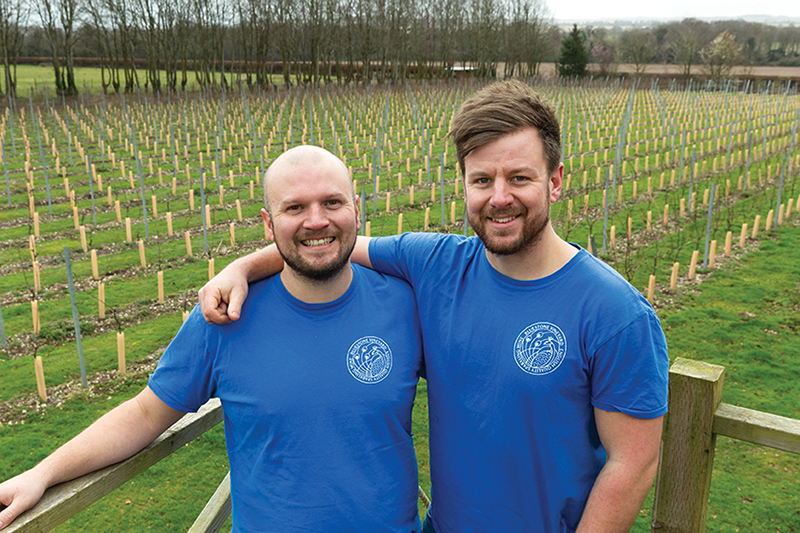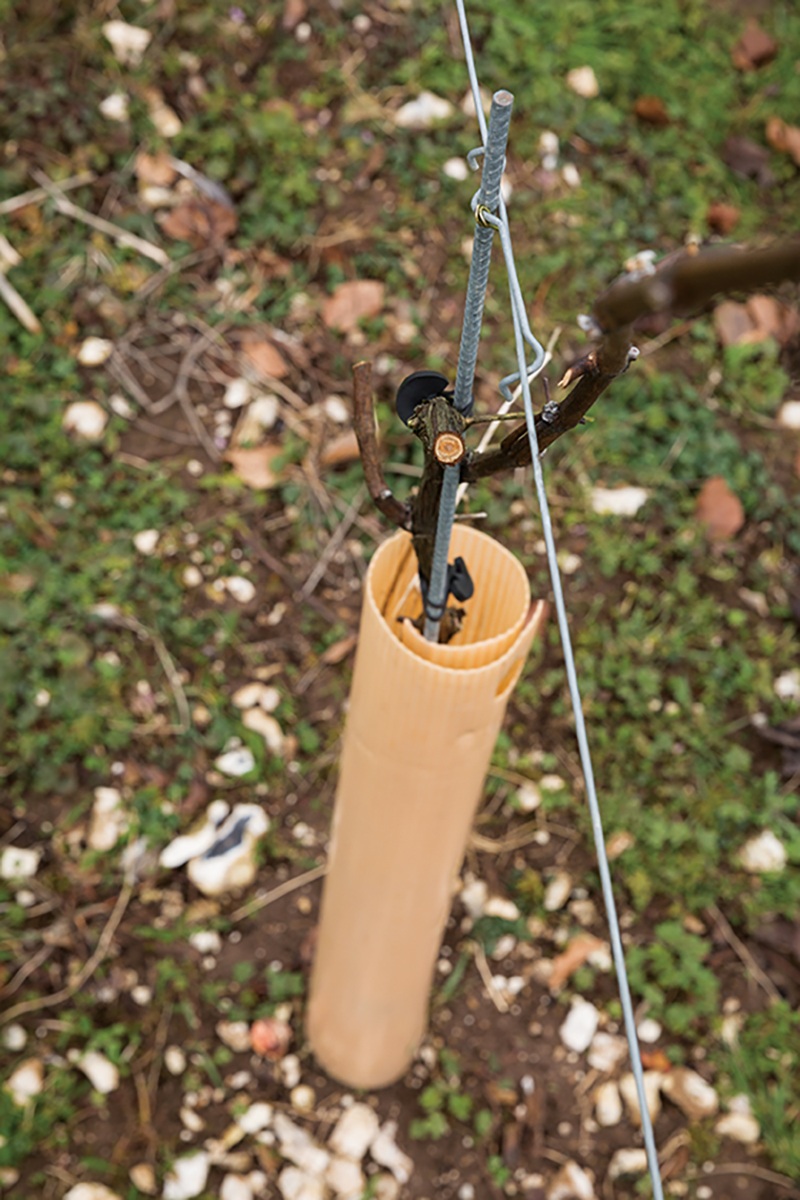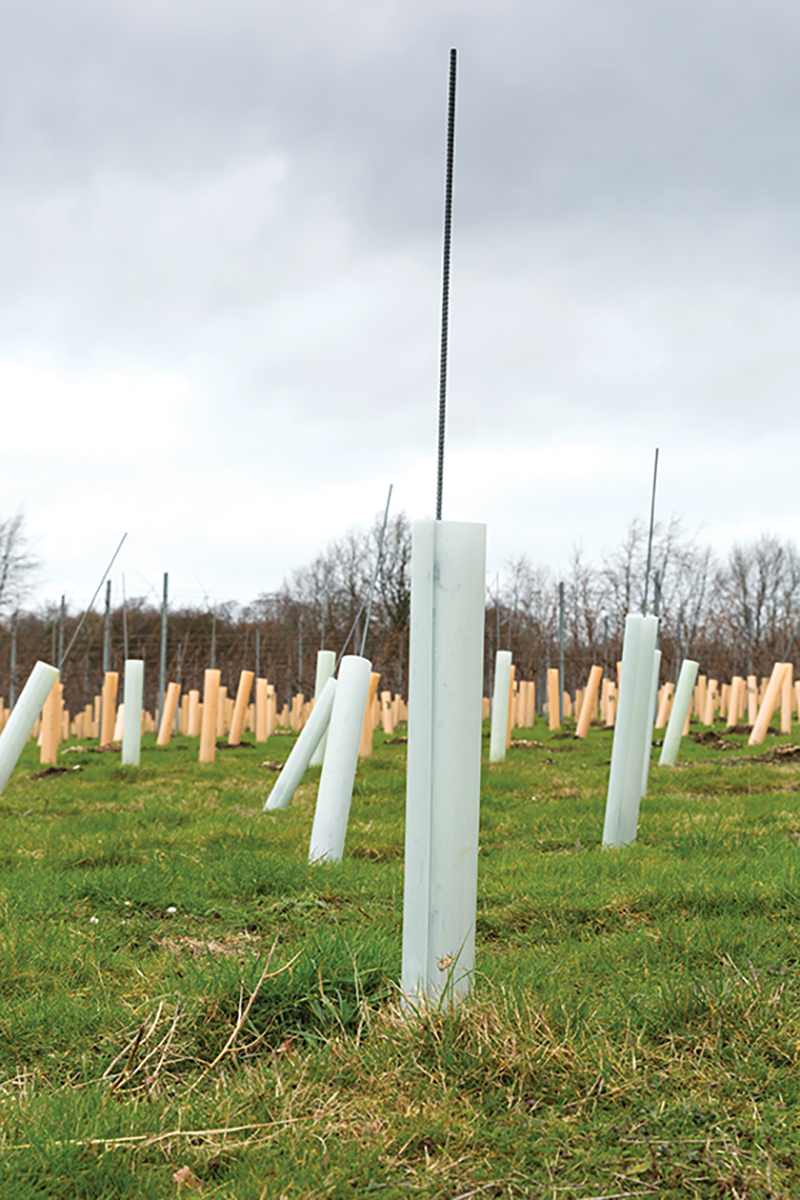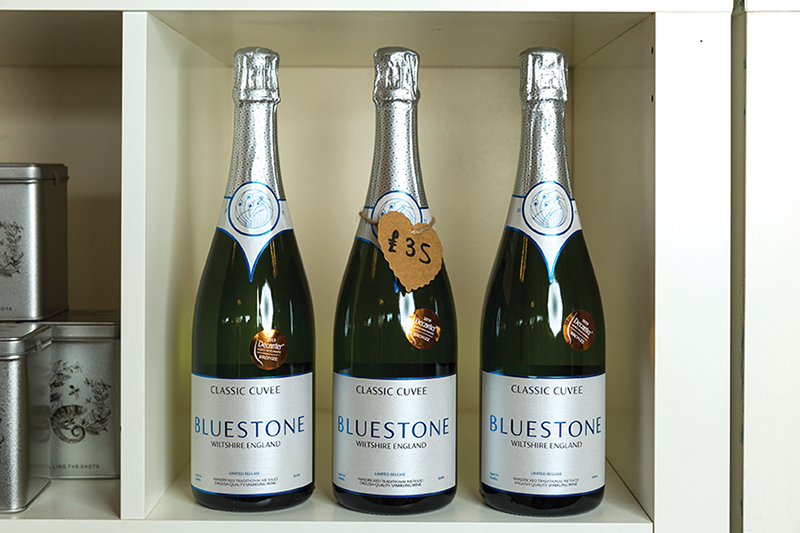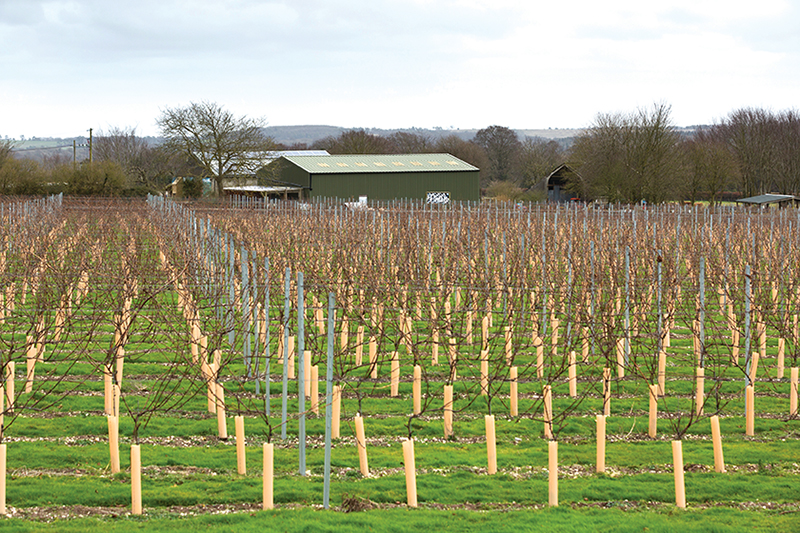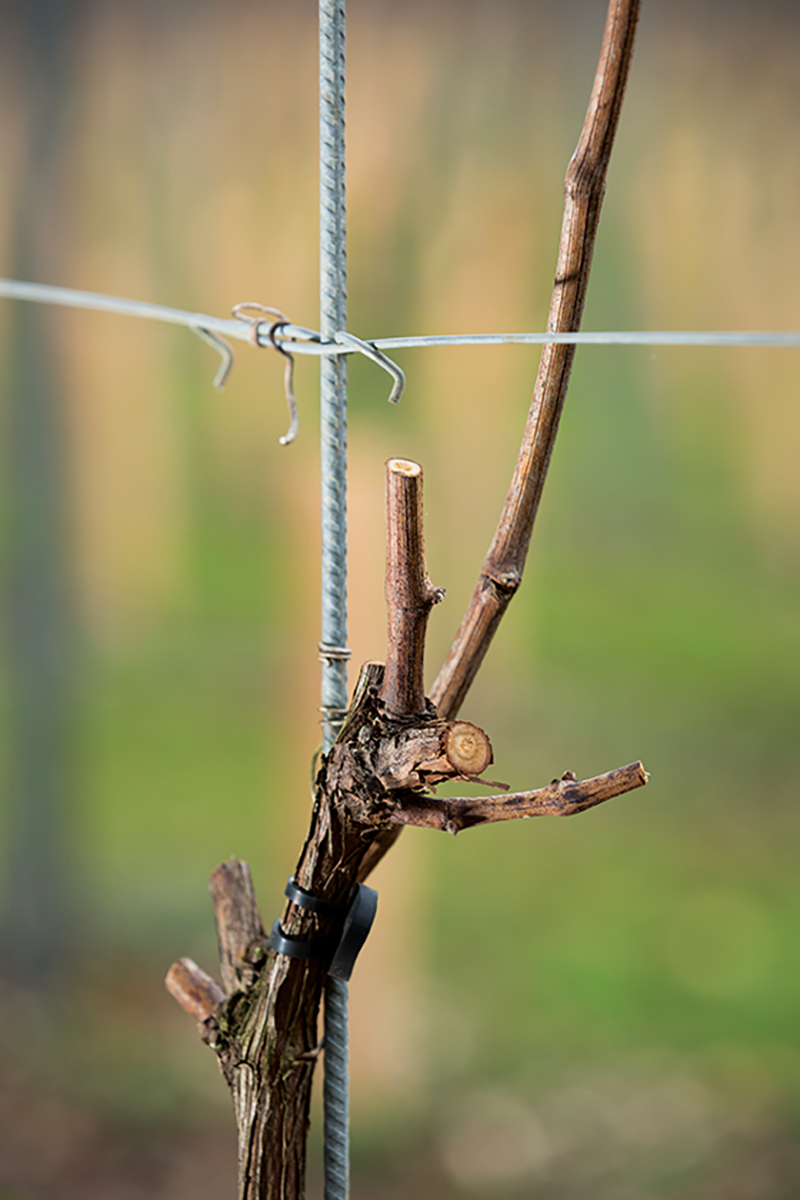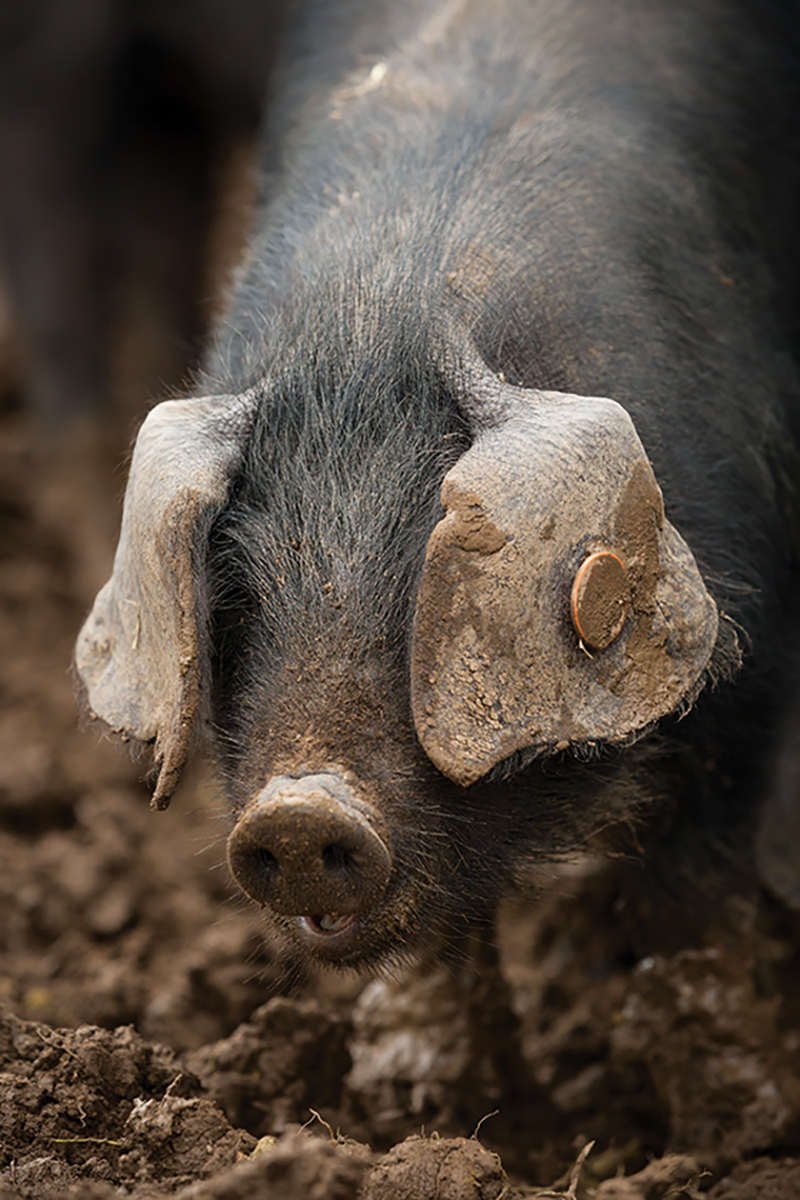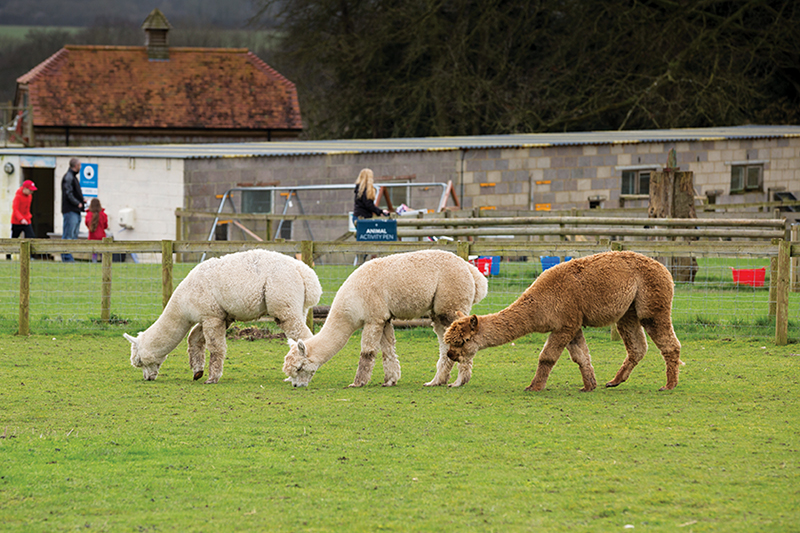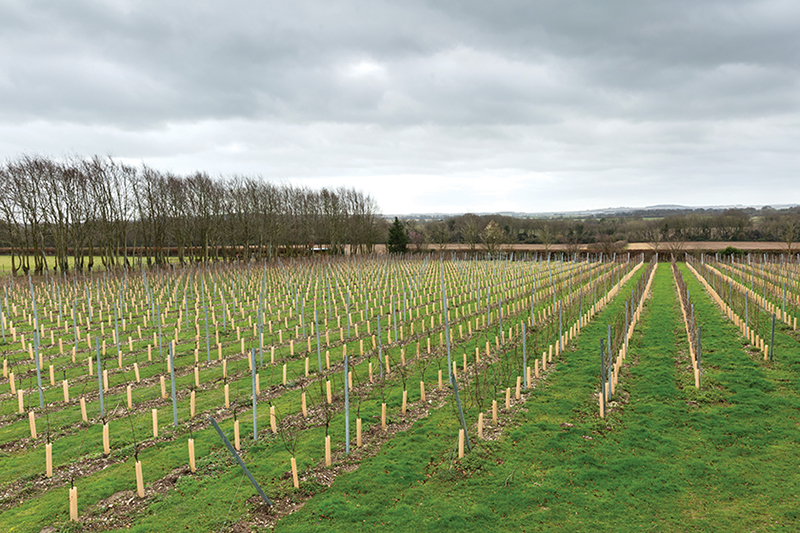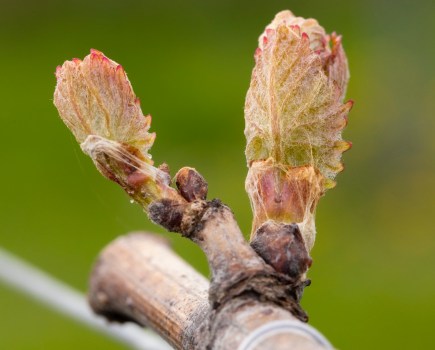The brothers seeking to earn their stripes in the vineyard before pushing sales.
Forgetting that it was the last Friday of February half term, as we turned into Cholderton Charlie’s rare breeds farm, home of Bluestone Vineyards in Wiltshire, the car park was heaving. As parents were busy unloading excited children ready for a fun family day out, it instantly struck me that the McConnell family had cleverly chosen to establish their vineyard on an already thriving tourism destination.
The Rare Breed Survival Trust (RBST) registered farm and visitor attraction receives 40,000 visitors per year. This would appear to be a captive audience for the estate wines, yet, walking through the farm gift shop, where a small selection of Bluestone Classic Cuvée was tucked away on a shelf, and into the café, whose tables were decorated with empty sparkling wine bottles, it felt as if this beautifully crafted English wine had unrighteously been appointed the role of a lonely wallflower.
Setting down their secateurs to meet with us, brothers Nat and Toby McConnell guided us through the yard, and as the vineyard came into view, I was once again struck by the contrast between the two businesses. While the farm was bustling with activity, the immaculate vines were seemingly encapsulated in a serene bubble.
“We have a premium product and the petting farm doesn’t quite sit with that,” explained Nat, whose parents took over the 40-acre smallholding around 20 years ago. “I am possibly trying to be too protective of the Bluestone brand, but as we are producing small volumes of traditional method sparkling, our wine retails at £35 per bottle and that is too expensive for the people who are here to visit the farm. We haven’t really pushed sales on-site; there are no signs in the shop and none of the staff are trained to talk about it.”
On the surface, shying away from shining a spotlight on the wine seemed to be a brave decision, particularly in an industry which is known for its cash flow woes. Digging deeper into the Bluestone project, however, it soon became clear that this is a savvy case of learning to walk before one can run. As well as expressing his underlying feeling that Bluestone’s wine is not yet where he would like it to be, Nat also delved into some ambitious plans; the family’s undeterred commitment to creating something with real personality, representative of the individual site and unique to the industry.
Steeped in history
Planted in 2016, the vines were part of a diversification scheme designed not only to add value to the McConnell’s existing business but to create jobs for Nat and Toby, who were returning to the family farm after respectively working in research science and hospitality.
“We have added various new developments to the farm over the years and turnover had always increased, but profitability hadn’t necessarily kept up,” said Nat, who named the vineyard after the ancient small stones located in the inner ring of Stonehenge located just a few miles away. “I didn’t really want to be involved in the farm and we were looking for other diversification ideas, but we only have 40-acres. Being RBST accredited we do a lot of conservation with British rare breeds, but we also had large flocks of sheep that didn’t really fit into this, so we started to look at what we could do with the 25-acres which was just being used for grazing.”
“We were considering truffles and artisan small-scale meat production and then, at the Farm Business Innovation Show we came across Vineyard Solutions, VSL. The vineyard is the brain-child of Toby, who suggested we look at planting vines. We discussed it as a family, researched the costs and the feasibility of our site and it ticked some boxes.”
The McConnell family had previous been advised that the site could be suitable for viticulture in the early-2000s, but with young children it wasn’t the right time for parents Jeremy and Pam.
“This time around everything aligned and we decided to go for it,” said Nat. “It is still in the very early stages, and there is a lot to learn, but as long as we do our best to get better every year, that’s all we can focus on. I certainly couldn’t imagine being behind a desk, and although there is a bit of that now we are getting into sales, there is no place I would rather be than out in the vines.”
The vineyards at Bluestone are spread across three sandy clay loam over chalk sites including the south facing Three Acre block, which was the first site to be established and is actually closer to 2.5-acres. The highest plot, sitting at 136-metres above sea level is called Top Field, which extends to another 2.5-acres and despite its altitude, performs well due to extended sun exposure and its well sheltered position.
Located on a site steeped in history, the third and largest parcel of vines (another 5-acres) is called Iron Age. Planted next to a byway, believed to have been the main trading route between Salisbury and Winchester, with a natural dewpond nestled at the bottom of the south-west facing sloped hill, the area where vines now stand would once have been a place for traders to take refuge and rest livestock along a busy journey.
“Our uncle is an archaeologist and before we planted the vines he came to dig up here,” said Nat. “We knew there was a lot of history in the area because of how close we are to Stonehenge. As well as arrowheads, Roman coins, and all sorts from across the ages, we found an old iron age roundhouse settlement at the bottom of the field.”
Showcasing the individual complexities
Not wanting to wait six years for the first wines to be released, the year before the Chardonnay, Pinot noir and Pinot meunier went into the ground, the family took the decision to purchase fruit from Hambledon Vineyard, Hampshire, whose winemaking team produce Bluestone’s range including the 2015 Classic Cuvée, which is now already available.
“Hambledon has a great team, there is a good pedigree of winemaking, they are very open, will help with anything and have been amazing,” said Nat. “But we don’t just want to become another contract-made sparkling wine brand and that is why I am really struggling with promoting the brand. I don’t feel like we have earnt our stripes yet. I find the fact that the wine we are currently selling is not made with our own fruit a little tricky and almost a bit dishonest, but I do tell everyone how it’s made because it’s important to be transparent. It will definitely be different when the wines are made just with our own fruit, and until we get full control and are able to talk customers through the different vineyard parcels and what makes them unique, I don’t think I will be happy.”
While aligning themselves with one of the serious players on the English wine scene has seen the development of a truly classic traditional method English sparkling wine, it is hoped that there will one day be a winery located at Bluestone.
“Personally, in the long term I would like to have the wines made on site,” said Nat. “As we are a small producer, I would love to be able to keep everything a bit more separate and perhaps look to do things on a parcel, or a clone basis. Hambledon are a big producer, so they don’t have smaller tanks to accommodate what we want to do.”
Across the three sites, three different Chardonnay clones, two Pinot noir, and one Pinot meunier were planted, but Nat points out that it is the way in which the sites were established which will allow them to pinpoint some particularly exciting parcels of fruit.
“The vineyard was planted by Ian Phillips at VSL, he is a great guy and we love him to bits. We don’t have many clones, but we do have a bit of each variety in each site. It might be a pain to manage, particularly when it comes to spraying, but it also forces us to pay more attention to the vineyard and we have noticed a huge difference between and within the fields.”
As well as wanting to see if they could produce a high quality, low yield Chardonnay, or keep a few rows of Pinot, which are “always way ahead of everything else,” separate at harvest, the McConnells would also like to use smaller tanks to showcase the individual complexities which come from their site.
“Last season we had to pick everything together, due to the way Hambledon make the wine, but this certain block of Pinot noir could easily have been harvested 10-days before anything else,” said Nat. “There are 12 rows of Chardonnay which have been performing well but because of tank space, everything is blended. Being on the small scale, we will only have a limited number of bottles per year and it seems odd to try and make them generic and samey.”
What works best for Bluestone
Regardless of where the wine is made, brothers Nat and Toby McConnell remain focused on growing the best possible fruit, with occasional help from dad Jeremy.
“We are all learning, but what I can guarantee is that we are willing to put the time in and are really good at growing grapes,” said Nat. “Dad is a builder by trade so works on other projects as well. He is famous for coming back and pruning the last vine, or picking the last bunch of grapes. He has been fundamental really and he is a great morale boost, but he does have a knack of knowing when there is only a small amount left to do.”
Both brothers are studying at Plumpton College; Toby has recently enrolled onto the vineyard apprenticeship scheme, while Nat is waiting to finish his MSc in viticulture and oenology.
“I enrolled in 2016 but my project has been on hold for a few years as I have been managing the day-to-day vineyard operations,” said Nat. “I also wanted to focus my project on something a bit different and I have decided to look at mycorrhizal fungi. Particularly I want to monitor populations and compare natural colonisation with vines which have been inoculated with mycorrhizal spores.”
Having taken a conventional approach to the vineyard soil preparations and on-going management so far, with a focus on foliar feeds and iron chelate injections, Toby is now keen to look at alternative methods, such as biodynamic preparations.
“We are planning to manage the Three Acre site biodynamically this year; we will see how it goes and what we can learn from it,” said Toby, who also emphasises that they are employing the gentle pruning method following the biodynamic calendar, with the day of my visit being an ascending moon. “We want to go down a rabbit hole and see where it takes us; it may or may not work. We need to start a compost and we need to look at what else goes into 501. Last year when we visited Albury, the vineyard was so pristine, the fruit on the vine looked amazing and it just made me question why we do what we do, why we spray and add to problems when we could follow different steps.”
Through Plumpton and speaking to other established producers, Nat and Toby have been able to develop their skills, but when it comes to viticultural practices, everything is carefully focused on what is right for their specific site.
“We are still very green to it all but even the people who have been doing it for years will all say different things and quite often methods only work for them,” said Nat. “We just have to find what works best for us, from both a financial and operational point of view. We need to learn the site and decide on the personality of our vineyard and our wines.”
Supply and demand balance
Taking a slow and steady approach, while there is another 10-acres of land on the farm which has been signed off as suitable for viticulture, planting plans have been reined in.
“From a feasibility point of view, the best field for a commercial purpose is adjacent to the sites we have planted now and it was in the pipeline to plant that in 2021, but we have decided to figure ourselves out first,” said Nat. “The WineGB marketing and business conference, scared me a little bit and why would you ignore experts who know what they are talking about? With everyone planting and producing lots of wine which is not yet being sold, looking at halting planting could rescue the supply and demand balance.”
Looking to the future, the McConnells are hoping to explore more sales avenues and will be increasing the wine tourism offering at Bluestone, which already includes tours, tastings and weddings.
“We are yet to look at markets like London, we haven’t gone knocking on wine merchants’ doors and we need to speak to more people interested in buying our wines for trade,” said Toby. “Over the last few years, it has been so hands on in the vineyard, racing against the clock to work through the time sensitive jobs and learning how to make our fruit better, but now we need to sell what we are producing.”
In the meantime, too, Nat is hoping to look at how the vineyard integrates with the farm and how the family businesses can work closer together.
“Marketing and sales isn’t my strong point and I am a bit protective with the Bluestone brand but when I have spoken to people about whether a wine brand and a petting farm go hand in hand, a lot think it is a great opportunity to have a day out with the kids, have a glass of wine at lunch, or take something home for the evening,” said Nat. “I don’t know if that will work, but we have to try it. I want to bring customers here to show them what we do and what makes us different. I want people to really connect with us so that when they go home they will speak about the amazing few hours they spent, the team and the wines. We need to focus on creating our customer base and developing those lifetime customers.”

